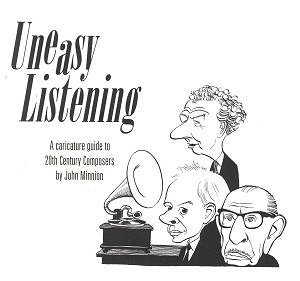Christmas heaves menacingly
into sight and the challenge of finding
presents for musical friends leers at
you yet again.
This book could be
your answer. It is a book of caricatures
of composers of the last century with
quite a few lingering, rambling or dashing
through into the present century.
John Minnion is the
artist and author of the book. You might
know his name. You almost certainly
know his art if you have any of the
Naxos series of Glazunov orchestral
works. Mr Minnion's Glazunov drawing
appears on the front of every one of
those Naxos disks. He began drawing
composers for The Listener in the 1980s
and later for Classic CD.
The book is in 200mm
by 210mm format.
He works in black and
white using clear lines and no colour.
Gradation and texture are eloquently
put across in stipple effects and contour
lines to suggest light and shade. He
is not afraid to use black - have a
look at his vital drawing of Leonard
Bernstein.
The book is laid out
chronologically with major fault lines
in musical history allocated more text
than the brief thumbnail commentary
allocated for each of the 100 or so
composers illustrated here.
I specially liked the
arachnid Rachmaninov, the Gollum-style
Schoenberg and the elvish Szymanowski.
Minnion’s RVW reminds me of Beavis and
Butthead of late night TV from years
back. Something similar can be seen
in the Panufnik sketch. Minnion’s Varese
is wonderful - about to explode. The
Weill is superb. It should be used on
the cover of a CD or something more
significant - if ever there is a Weill
festival somewhere this would make a
superb poster! Then again there is horrified-frightened
Walton , the extruded Martinů,
Lutyens looking like something from
one of the Hammer horrors for which
she provided scores and scorn. Cage
and Stockhausen are great with a craggy
Lenny Bernstein a festively unhinged
Arvo Pärt, a beaming Nancarrow and turniphead
Turnage!
Each year of the century
is listed with a few key works from
each of those years in a panel next
to the main business. And what is the
main business? This is the sequence
of drawings and the personal entries.
The entries are pretty informal. Puccini
for example is listed as having hobbies
including sexual infidelity. Mr Minnion
is not short of world views either for,
as he says, while romanticism was chided
and derided it never went away and 'it
may be that classical music has lost
its way without it and may never claim
it back again'. Personally I think that
is too gloomy a prediction but who knows.
This is wonderfully
well done as a book of illustrations.
It tells us something of the psychology
of the composer in each case and does
so wittily and not without taking a
few dangerous corners.
Rob Barnett
